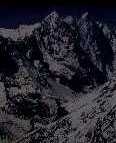
Kyanji Gumba, Langtang
more detail...
|
LANGTANG NATIONAL PARK:
Langtang National Park catches two major river systems. The Trisuli River draining into
the west and the Sun Koshi river to the east. The area is located north of Kathmandu
towards the Tibetan border.
Varied climatic patterns along with the area's complex terrain have allowed a wide variety
of vegetations types to establish. Oaks, chir pine, maple, fir, blue pine, hemlock,
spruce, and various species of rhododendron make up the majority forest species.
Subtropical forests are found at lower elevations. Temperate Oak and Pine forests situate themselves at mid-elevations. And the
snow and bare rocks of higher elevations are areas where alpine scrub and grasses grow.
The forest environment with its varied climatic patterns and altitudes provide a habitat for
a wide range of animals such as : wild dogs, red pandas, pika, muntjack, musk deer, Himalayan black bear,
Himalayan tahr, ghoral, serow, rhesus monkey and common langur. The river areas form important migration routes
for birds flocking between India and Tibet.
People living around the area are of mixed cultures. Several ethnic groups have influenced
the natural environment for centuries. The Tamang people comprise the majority of the population.
The Tamangs, traditionally farmers and cattle breeders, are especially well known for their weaving.
This ancient Nepalese race follows a religion related to the Bon and the pre-Buddhist doctrines of Tibet.
Paraphrased from : http://www.south-asia.com/showcase/Tour
|
